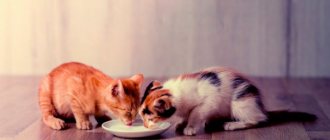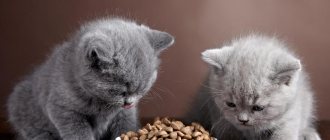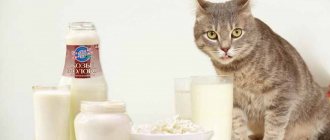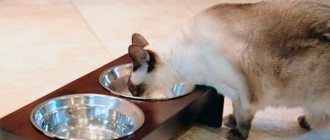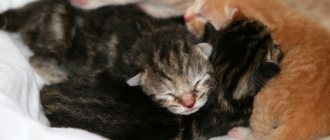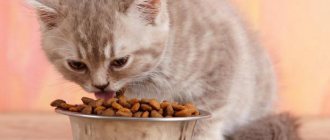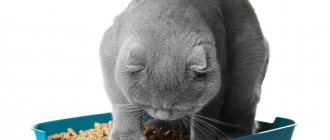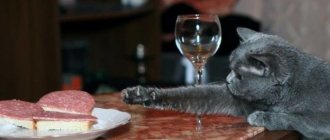Is it possible to use human baby food?
The mention of newborn kittens always brings a smile. These babies seem just like babies - why not save on cat food and buy regular infant formula? Is this allowed? Let's try to figure it out.
Your pet is an individual with its own characteristics of health, character, and level of activity. The nutritional needs of kittens and newborns differ significantly, although there are often cases when baby food becomes the saving grace in artificial feeding of a kitten.
Infant formula can be used in three cases:
- For feeding kittens – sucklings left without their mother ahead of time. In this case, the powder is adjusted with water to the desired consistency in a ratio of 1:1.5.
- If you have an allergic reaction to cat food or congenital diseases in your pet.
- As a dietary supplement.
Canned meat or vegetable purees should not contain salt, pepper, starch or onions. These components will not be digested in the kitten's body. A one-month-old baby can be offered Agusha baby puree - an inexpensive and high-quality option for feeding small children.
Convenient feeding option
How to accustom a kitten to new food
Not all kittens at this age willingly give up cat milk in favor of new products. In such a situation, the owner will have to make great efforts so that his pet begins to get used to the new food:
- Porridge - boiled in water or milk diluted with water in equal parts. No salt or sugar is added. The porridges are made very liquid at first. As the kitten readily eats boiled cereals, they need to be made thicker.
- Meat. Despite the fact that this product is the most natural for representatives of the cat world, kittens may be reluctant to try it. What to do? Boiled lean meat is ground in a blender to a puree. When the pet gets used to the new dish, pieces of finely chopped meat are added to it. Gradually they are becoming larger in size.
- In the same way as with meat, proceed with fish fillet, making puree from it, gradually increasing the volume of the pieces.
The kitten is also gradually accustomed to commercial food. Wet food and canned food are crushed with a fork. Dry granules are filled with water and then ground to a puree.
How often
The most common question is how many times a day should you feed. Most one-month-old kittens happily eat 6 times a day. Pay attention to your pet's behavior. Does he squeak displeasedly and show concern?
So it’s time to refresh yourself! On average, a kitten will eat 120 grams of food during the day. If he eats less, he may not like the food offered. A viral infection cannot be ruled out. In any case, this is a reason to contact the veterinarian.
By the month of month, night feedings can be removed if the pet sleeps peacefully throughout the night.
External signs indicate that your fidget is happy with life and does not feel hungry:
- the kitten has a dense build, the costal arches are not visible from under the skin, but can be easily felt;
- he is calm and active, does not squeak between feedings;
- mucous membranes are pink-colored and moist;
- light brown decorated chair;
- daily weight gain of about 10 grams.
An approximate feeding schedule looks like this: 6.30, 10.00, 13.30, 17.00, 20.30, 24.00. After a midnight meal, the kitten will be ready to fully rest until the morning.
Feeding frequency and portion size
When feeding “dry”, it is enough to focus on the norms indicated on the packaging. By weighing your pet, you can easily find out its daily portion.
The frequency of feeding depends only on age, so it is the same for pets with different types of nutrition. The recommended number of meals and portion sizes on natural food can be found in the table.
| Age | Feeding frequency (once a day) | Daily serving size |
| Up to 2 weeks | 10, including night time | 30 ml per 100 g weight |
| 2-3 weeks | 9, including night time | 40-45 ml per 100 g weight |
| 3-4 weeks | 8, including night time | 50-55 ml per 100 g weight |
| 1-2 months | 7 | 120 g |
| 2-3 months | 6 | 150 g |
From three months of age, the portion size is increased to 200 g per 1 kg of weight, and the number of meals is reduced to 5. From this moment until six months, the animal enters the most active growth phase. At this time, veterinarians recommend taking into account the individual characteristics of the pets and monitoring their well-being by checking their indicators in the clinic. If you deviate from the norm typical for your pet's breed, you may need to increase or reduce the usual portions.
If you are often away from work, make sure that your friends, relatives or neighbors feed the kitten. Eating too infrequently can lead to overeating or exhaustion. After six months, your pet can be safely switched to three meals a day, and closer to a year - to two meals a day.
Is dog food allowed?
The curiosity of a little researcher has no limits. Now he is confidently reaching for the dog bowl. Surely the owner is also wondering whether the kitten will like dog food?
Ready-made dog food smells and tastes different from cat food. This is due to the different nutritional needs of cats and dogs, and, as a result, the different composition of the finished product. Cats are given mixtures with a high level of protein starting from birth.
In addition, in a dog’s body, vitamin A is able to be formed from ß-carotene; cats do not have this ability. Simply put, you can satisfy a kitten’s curiosity once, but under no circumstances should you do it constantly! Over time, the pet will develop a lack of nutritional components and metabolism will be disrupted.
By the way, the nutritional value of cat food is always higher than that of dog food.
Is it possible to dry
Veterinarians have different opinions regarding the age at which a kitten can try “adult” food for the first time. Some of them do not recommend introducing dry food to your pet before 2 months, while others follow the principle “the sooner the better.” The owner decides whether or not to give such food to the baby.
A one-month-old baby’s baby teeth have not yet become strong, and the jaw muscles are not sufficiently developed. If you want to take the risk, soak the dry granules in warm water first to make them easier to chew.
To ensure successful adaptation to new food, follow simple rules:
- do not exclude formula milk until the baby is at least 2 months old;
- do not exceed the daily dose of dry food (20 – 30 grams per day);
- if the brand of food does not cause negative reactions, do not change it;
- Divide the total daily dose into three feedings;
- monitor compliance with the drinking regime;
- Do not use food for adults.
Advice! Do not give your pet additional vitamin complexes. Dry food already contains minerals and trace elements.
Feeding kittens with dry food
Industrial feeds have two advantages: they contain nutrients in the right quantities and proportions, and feeding does not take much time. Doctors' opinions on when to start complementary feeding differ. Some do not recommend dry food until two months.
Others advise preparing digestion for adult food from the age of one month, observing the following rules:
- Mother's milk or a milk substitute is left in the diet until the kitten is two months old.
- Do not mix industrial and natural products so as not to disrupt digestion.
- Dry food is introduced gradually and only in a softened form. On the first day, feed one lump, soak it in the mixture or kefir, knead it with a fork and put it in your mouth. The next day, the portion is increased to two granules, and gradually brought to the permitted volume. The amount of liquid for soaking is gradually reduced.
- The daily intake varies from 20 to 30 grams for different manufacturers; this is specified in the instructions.
- The daily volume is divided into equal parts and fed 3 times a day.
- They do not change the brand of food, but if gastric disorders or allergies begin, you will have to choose products from another manufacturer.
- Economy class food is not suitable, it does not contain enough nutritional components, and synthetic flavoring additives often cause allergies.
- Products are not suitable for adult cats.
- Additional vitamins are not given to prevent hypervitaminosis from developing.
More water is required than with natural nutrition, so its availability is monitored with double attention.
Is it possible to have homemade food from the table?
This is strictly prohibited for kittens!
If you follow a strict diet without salt, sugar, spices, and also do not eat spicy, smoked, fried foods, then yes, you can periodically feed your baby from your table.
In all other cases, human food is not suitable for a kitten. Even if it’s sausage made from natural products or homemade preserves. Extra fat, calories and preservatives are not good for anyone.
Another product strictly prohibited is potatoes. Neither boiled, nor fried, nor in any other form. It simply cannot be absorbed by the cat’s body.
What should you not feed a one-month-old kitten?
You need to pay great attention to the nutritional options and standards for a small pet. After all, this is not an adult animal with an established organism and its digestive organs are still in the development stage. Keep in mind that a lot depends on how correctly you feed your baby - even his life, so every caring owner should understand this.
Milk and meat
As for milk, it is better to take goat or dry milk, sold in specialized stores for animals. If we take dairy products as the basis of nutrition, then products with a low fat content are better suited for the animal.
You should not feed your pet raw meat; it contains worms and pathogens. And the baby’s body will not cope well with such rough food.
Monotonous food
The kitten does not need to be fed monotonous foods. For example, give one fish or one cereal. This feeding option leads to the fact that the baby will receive an insufficient amount of useful minerals. Also, if a one-month-old kitten is not accustomed to a variety of cuisines, in the future he will become very picky, which will cause certain difficulties.
Food from the table
The kitten does not need to be fed food from the table. It contains a lot of spices that are unnatural for the baby’s body. It is harmful to give sausage and various smoked meats, and it does not matter what is included in their composition. The same applies to pickles, because all these products can be called food for people, containing excess fats, salt and other ingredients.
You can't give potatoes. And this applies to root vegetables in general. It doesn’t matter whether the tuber is raw, boiled or fried, remember - a kitten’s stomach does not digest potatoes.
Fatty food
A small pet does not need any food containing a lot of fat. Therefore, it is better not to give such foods as cheese, butter, fatty meat at first, but to feed the baby gradually.
- Bones (bird, fish) are another harm for the cat family in general.
- Pork - this type of meat is completely unnecessary for kittens; it is not only useless, but also poses a potential threat.
- Any food for dogs and puppies is not suitable for a baby kitten. They contain completely different components that are required for the full growth of the baby.
- It is better not to give your pet sweets or rich yeast rolls.
- Don't forget one rule - you can't feed your kitten different foods and mix natural food and ready-made food.
Forbidden homemade food
There are two types of cat owners. The first one will say: “Eat what they give you!” and persistently offer the pet a convenient option. The second owner acts on the principle “Eat something!” and will offer anything to squeeze an extra spoonful of food into your pet. Both strategies are fundamentally wrong. Food should be healthy, even if your cat doesn't agree with it.
When choosing a diet for a kitten, you should take into account the harm that a particular product can cause:
- Salt, sugar, marinades are substances that disrupt metabolism.
- Fish with bones - to avoid injuries to the gastrointestinal tract.
- Pork – contains too much fat, risk of helminth infection.
- Potatoes are not digestible due to the large amount of starch.
- Legumes – provoke gas formation in the intestines.
- Fish (more than 2 times a week) – risk of urolithiasis.
- Caffeine-containing drinks put a strain on the nervous system and heart.
- Vegetables – broccoli, avocado, garlic, tomatoes and onions. The specific composition of the products is not suitable for feeding a kitten.
- Nuts are harmful to the kidneys due to their high phosphorus content. In addition, the pet may choke if it eats carelessly.
- Raisins cause flatulence.
- Mushrooms are capable of accumulating toxic substances.
Choose your cat's food basket taking into account these requirements, and your kitten will be absolutely happy.
The need for vitamins and supplements
Vitamins and minerals are an important part of a balanced diet. You can't go to extremes here. An excess of these elements is no less dangerous than their shortage.
Owners who feed their pets “natural” often face the problem of hypo- and hypervitaminosis. By relying on calcium and fish oil, they often overdo it and forget about other important nutritional elements. It is very difficult to reach the recommended amount of vitamins and minerals without the help of a veterinarian, so it is better to immediately seek help from a veterinary clinic. After the examination, the doctor will be able to adjust the existing diet and select the drug complexes necessary specifically for your pet.
When dry feeding, it is enough not to skimp on the quality of the feed. All the necessary elements are already included in the composition, so deviations can only indicate the presence of pathology.
A balanced diet, observed from early childhood, will provide your pet with strong immunity for the rest of its life. Avoid prohibited foods, do not mix different types of food, and be sure to consult a veterinarian with any questions that arise. Remember that every body is different, so some recommendations may not be suitable for it.
The article is for informational purposes only. Contact your veterinarian!
Norms
Below is a table with a detailed description of food products and the frequency of their consumption by a kitten aged 1 - 1.5 months.
| Product type | Frequency of use |
| Lean meat | daily |
| Fish without bones | 1 – 2 times a week |
| Boiled chicken | 3 – 4 times throughout the week |
| By-products | no more than 3 times a week, liver – 1 time a week |
| Egg yolk | no more than 2 times every 7 days |
| Greens (lettuce, spinach) – mixed with cottage cheese | up to 2 times a week |
| Dairy | every day |
| Vegetable oil (a few drops) | in a day |
| Milk porridge | daily |
| Non-acidic cottage cheese | 3 – 4 times a week |
| Vegetables | several times during the week |
| Fermented milk products | every day, cheese - no more than once a week |
| Cereal porridge | several times over 7 days |
| Fresh drinking water | must be available at all times |
Natural solid food
A one-month-old kitten does not have enough milk or formula for normal growth and development.
If you plan to feed him natural food in the future , then the following products are added to the diet:
- Beef , poultry meat . First they boil it, then finely chop it or grate it. If the kitten refuses to chew, they start with meat puree for children: smear it on the palate, then put it in a saucer. Gradually add chopped meat and gradually replace it with puree.
- Liquid porridge made from ground oatmeal . The “dish” is prepared without sugar and salt.
- Low-fat cottage cheese . Before use, soften or strain through a strainer and dilute with milk. It is useful to use children's homogenized cottage cheese, it contains all the microelements necessary for the formation of the skeleton.
- Vegetables . Carrots, zucchini, broccoli are boiled and chopped, served with broth or as a puree. Ground meat is added to the dish.
- Eggs . Doctors recommend raw quail eggs; cats cannot digest boiled ones.
- Lean fish . They are given only boiled in small pieces.
- Unsalted cheese . Before use, grind on a grater.
- Fresh grass . It is bought in specialized stores or grown on a windowsill from cereal seeds and placed in an accessible place.
From the first day of complementary feeding, it is important to ensure that the kitten has clean water available around the clock. It is poured into a separate container and changed three times a day. Breeders advise placing 2–3 bowls around the apartment in suitable places, and not using plastic utensils.
Feeding a kitten at the age of 2 months
Feeding a kitten at six months
Feeding a kitten aged 1 month
Features by breed
Each cat breed has its own feeding characteristics. Let's look at the nutrition of the most popular purebred kittens - British, fold and hairless breeds. If you are the happy owner of such a pet, you should study their needs in more detail.
British
Kids of this breed grow rapidly and gain weight, and have a stocky build. From birth, British cats and Chinchillas need high-calorie food; their diet should contain about 65% meat and 25% vegetables.
Warning! Vitamin supplements for the British are selected to take into account the increased need for calcium. Products of natural origin Canina and Gimpet have proven themselves well.
The natural blue color of the pet changes with frequent consumption of carrots, liver or kelp. This fact must be taken into account when cats participate in exhibitions and competitions.
Scottish Fold
Scottish Fold
Fold-eared babies up to 3 months of age eat at least 6 times a day. This active baby quickly gets full and begins to feel hungry again. Some breeders note that the more nutritious a pet’s diet, the better their coat looks.
There is an interesting sign: if the Scots are fed cow's milk, then their adjacent ears will “stand up” due to high doses of calcium and the kitten will lose its attractiveness. Of course, this is nonsense. Folding is a genetic feature and has nothing to do with feeding. And the birth of a kitten in a litter with erect ears is simply natural selection.
Representatives of the breed have a congenital tendency to allergies, arthrosis and urolithiasis. When choosing a diet, focus on high-quality food without flavorings or preservatives.
Bald
Owners of Don Sphynxes, Canadian Sphynxes, Bambinos, Dwelfs, Ukrainian Levkoys and other hairless breeds know that their pets have a healthy appetite and are absolutely undemanding when it comes to food. Their weak point is a sensitive digestive system and a tendency to obesity. It is this combination of “a constant feeling of hunger - excess weight” that determines the principles of nutrition for the Sphinxes. You must:
- Ensure a strict feeding schedule without unsupervised access to the bowl.
- Dosage the amount of feed in strict accordance with the manufacturer's instructions.
- Feed your pet for a certain amount of time, taking the bowl away after it expires.
Due to the lack of fur, Sphinxes spend a lot of energy. Their diet should be high in calories and varied. Pets have delicate skin, which requires zinc, B vitamins and polyunsaturated acids to keep it in good condition.
Are there any peculiarities in feeding small kittens of different breeds?
Feeding different kittens may vary depending on the breed.
Caring for any breed has its own nuances. For example, it is not customary to give liver to babies of Russian Blue cats and Gray Nibelungs. It is believed that this product gives the fur a brown tint, although many breeders recommend feeding kittens with liver from at least one and a half months. It is recommended to feed British kittens a nutritious diet. Britons are stocky animals, kittens grow quickly, rapidly gaining weight, but these animals cannot be called lazy. The diet of such a kitten should contain at least 65% meat products, and vegetables - about 25–30%.
Scottish kittens (Scottish Folds and Scottish Straights) under 3 months of age should eat at least 6 times a day. Active cats quickly begin to feel hungry. Some owners of Scottish cats note that the more nutritiously you feed the kitten, the better its coat “fills up.” I had to read recommendations and advice on feeding Scottish cats on forums. One breeder wrote that the more difficult it is to prepare porridge (4-5 grains at a time), the thicker the animal’s fur becomes. And some even choose a mixed type of feeding. Moreover, kittens are given high-calorie foods as an additive to store-bought food.
I feed my Scottish dogs Royal Canin dry. Kittens are on Bebika, adults are on Fit 32. Plus frozen turkey beef. I also give quail eggs with cream to kittens.
kroin, regular visitor to the forum
https://forum-wec.com/index.php?showtopic=170823
Scots need to be fed often and nutritiously
There is a lot of controversy about the nutrition of small Maine Coons. However, every breeder recommends closely monitoring the baby’s diet. Cubs grow large; a three-month-old kitten can be the size of a regular adult cat. The food for such cats should be dense and plentiful, but the kitten should not be overfed (regular overfeeding leads to obesity and other problems).
To teach your Maine Coon to eat on his own: spoon the pate into his mouth. No bottles. Standards are based on weight, read on the food packaging. And no variety: chickens, etc. Nothing except dry meat and pate. The total number of feedings is 5 per day. Pate per feeding - from a teaspoon.
carrot, forum user
https://www.mainecoon-forum.ru/showthread.php?t=46147
With ready-made food, everything is much simpler. Manufacturers of elite baby food take into account the characteristics of breeds. For example, Royal Canin, which produces food for 6 different breeds of kittens, has developed the British Shorthair series. This food is presented in the form of large granules of a special curved shape. The busy British cannot swallow such an “inconvenient” faction; they have to chew it. In addition, the packages of store-bought food always indicate the daily intake for a kitten, the volume of a single serving and other details.
Video: Sphynx kitten wants to eat porridge along with a plate
Feed from different manufacturers
Having studied the packaging of ready-made food, we see that each manufacturer considers its products to be the best for kittens. It would seem that by taking the “best” from different manufacturers, you can provide your pet with all the necessary substances plus diversify its diet. However, everything is not so simple.
The product line of each brand is developed with its own characteristics in composition, combination of components and vitamin and mineral supplements. By choosing one brand for feeding, you can be sure that the components of the feed are interchangeable and complement each other.
By purchasing different foods for our pet, instead of proper nutrition, we risk getting complications from the gastrointestinal tract or, even worse, irreversible metabolic disorders.
If the kitten eats one brand, he is cheerful and playful, and does not show anxiety, do not change the food. This will protect you from problems in the future.
A few words about ready-made food. When a kitten owner prefers commercially prepared food, only brands marked Premium or Superpremium should be selected. Products in the mid-price category are not suitable - they have an unbalanced composition and often use low-quality raw materials. Special lines of ready-made food designed for 1-month-old kittens are produced by many companies with a proven reputation:
- Royal canin food labeled Mother and Babycat. The product is approved for use by kittens over one month of age. Available in granular form, quickly soluble in water. The food contains easily digestible protein, which is necessary for the normal development of the pet.
- Hill's Science Plan Kitten Mousse and Granular Mix. The manufacturer of this food focused on natural ingredients, such as turkey and poultry protein.
- Arden Grange Kitten - food with the addition of prebiotics (substances to improve food digestion). The protein level in the mixture is 34%.
- Perfect fit Junior is a ready-made mixture with conflicting reviews, despite its attractive price and high-quality composition. The food, containing 24% protein, is additionally fortified and enriched with mineral components.
- Eukanuba Cat Kitten is an industrial food made from chicken liver and chicken meat. It has a high protein level – 36%. Without preservatives or flavor enhancers.
- Pro plan junior is an industrial feed with an optimal composition. In addition to 20% chicken meat, the composition includes cow's colostrum to enhance immunity and form normal intestinal microflora. Protein levels increased to 42%.
When choosing food for a kitten, you should focus on both the composition and the baby’s individual needs. Almost all premium-class food has a wide range of finished product flavors that can satisfy the little picky eater.
Is it possible to feed a kitten 1–1.5 months old with ready-made food?
Veterinarians and breeders have been arguing for many years about what is better to feed kittens - ready-made food or natural food. One thing is clear - mixing these types of nutrition is extremely undesirable. Some people choose industrial feed for two reasons:
- Saving time (no need to spend time preparing food).
- Ready-made feeds already contain correctly balanced nutrients, minerals and vitamins.
But those who have made their choice in favor of ready-made food need to know the following:
- You need to stick to one diet. If the house has run out of food, you cannot feed the kitten natural food (the baby’s body will suffer). Consequences: gastroenteritis, intestinal obstruction, etc.
- You cannot “jump” from one food to another. Each brand of food has its own recipes and principles (if you mix food from different brands, an imbalance of microelements or, for example, amino acids may occur).
- You need to choose only high-quality food (premium, super premium or holistic).
But not whiskey, not friskas, and not kitiket: there are special flavoring additives, but nothing useful. There is also food in bags or jars. This, of course, cannot be left in a bowl for a long time, but if there is an opportunity to stop by, then eating three times a day will be enough for him until the small one 250 grams per day is enough for him.
Fretka, forum user
https://forum.academ.info/index.php?showtopic=221934
If you decide to feed your kitten ready-made food, then it should be the best food you could find.
If the food is premium or super premium, there should be no problems, if “economy” such as whiskey, friskas, etc. - whatever. In nurseries, all cats on premium food are healthy and shiny, because... there is a balance of vitamins and microelements, and so you have to calculate everything yourself, and if you are not a specialist, then there will be a lack of vitamins or their overdose, which is even worse.
https://bvf.ru/forum/showthread.php?t=970243
Kittens prefer special wet food (canned food in jars or bags, as well as pates). However, dry food is cheaper, and some veterinarians believe that it is also healthier. There is a significant difference between these two types of feed in drinking mode. Wet food is 70-80% water, but dry food requires a lot of water. Month-old kittens fed the so-called “dry” diet are fed porridge from dry food - the granules are soaked in water. Gradually the amount of water is reduced and the amount of feed is increased. The most popular premium and super premium food for kittens are the following brands:
- Eukanuba Puppy Kitten;
- Royal Canin (Size Nutrition Mini Junior or Mother And Babycat);
- Bosch Sanabelle;
- Hill's Science Plan Kitten;
- Almo Nature;
- Pro Plan Junior, etc.
Photo gallery: some types of food for kittens at 1–1.5 months
Almo Nature food for kittens contains at least 50% animal protein and 14% non-allergenic rice
Bosch Sanabel kitten food is produced in Germany, the product composition is well balanced
Eukanuba food contains a lot of proteins, including 43% animal proteins (domestic chicken)
Hill's is famous for its rich composition of vitamins and minerals, but it may contain a large percentage of difficult-to-digest carbohydrates
"Proplan" can be bought in almost any pet store, it is very popular among Russian breeders
Seeing the price tag on a package of good food, the kitten owner may change his mind. But these numbers seem large only at first glance. After all, you don’t need to give a lot of good food (the kitten won’t remain hungry anyway), and with a balanced diet, you don’t need to buy any additional products (all vitamins are already included in the product).
Akana Grasslands food: A bag of Akana costs 2,250 rubles per 7 kg bag. 7 kg for two kittens for 55 days. The total weight of kittens is 5.72 kg 63.5 g per kitten per day. 1.972 kg per month per kitten. 22.2 g per kilogram of kitten per day. 690 g per kilogram of kitten per month. 20 rubles per kitten per day. 630 rubles per kitten per month.
Squirreland, regular forum visitor
https://forum-wec.com/index.php?showtopic=170823
Of course, a large package of food is always more profitable than several small ones. However, here you should take into account the number of kittens, the amount of food they consume per day and the shelf life of the product. I try to take medium-sized packages, since the food may run out before the kittens eat it. It is advisable to choose the packaging that has the latest production date.
How to teach a one-month-old kitten separated from its mother to eat on its own
Cow's milk
By the third week of life, a healthy kitten develops a healthy interest in food, because nutrition is one of the basic instincts for the survival of an individual.
All that is required of you is to unobtrusively encourage your pet to become independent, while monitoring its safety.
Start with milk. After dipping your finger, give the kitten the opportunity to sniff and lick it, then gently push the baby's face towards the bowl.
Perhaps he will sneeze or even get his front paws into the milk, this is absolutely normal, because he is still learning. But don't let him see food as entertainment. Accustom your baby to a culture of nutrition from childhood and in adulthood you will get a cat with a balanced character and adequate actions.
After a few days, the kitten will eat on its own, and you can gradually introduce the first complementary foods. First, these should be dishes of a delicate consistency - thin porridge, raw meat pate with broth. Grind harder pieces of food with a blender.
Dry food is the most difficult food for a pet. It is moistened with liquid until the baby begins to eat confidently and accurately.
How to feed a kitten correctly?
When purchasing an animal, you need to know how to care for a month-old kitten, what to feed, and most importantly, what to do so that it does not refuse food. After all, at this age, kittens are still helpless and weak.
If the animal refuses to eat on its own, you can try feeding it with a baby bottle or syringe. After this, it is advisable to massage the stomach with smooth movements so that the food is better absorbed. This method should be used only in extreme cases.
Scientists have proven that after 20 days of life an animal can lick food independently. To do this, you need to dip the tip of your finger in the milk and touch the kitten’s nose. After he licks them, you should carefully push the cub towards the plate. If the kitten fails to lick the food on the first try, you need to repeat the procedure 2-3 times.
Expert advice
Habits play an important role in a kitten's life. The sooner he gets used to a strict daily routine, the easier it will be for him to get used to new conditions.
The best shampoos for cats, both regular and specialized medicinal, rating of popular ones
The feeding area should be quiet and secluded, always away from the tray.
Having chosen a meal schedule, do not change the hours unless necessary, so as not to cause anxiety to your baby. Advice! Buy dishes and feeding supplies made from safe materials that are easy to clean and without sharp parts.
A kitten is an extremely demanding creature; it will not eat from a dirty or uncomfortable bowl. If we see a situation where “the kittens have grown a little, but they don’t want to eat from the bowl,” then before you panic, pay attention to the pet’s behavior. Is he cheerful, active, moderately cheerful? So the problem is not health. Try changing your feeding accessories, the issue may go away.
Do you have several kittens living in the apartment? Separate their bowls in different corners of the room, do not allow competition and hostility.
Feeding mode
A 1 month old kitten should be fed every 4 hours, the portion size is small. Night feeding is not necessary. The total amount of food per day is about 100 g.
Due to the fact that at this age a kitten cannot control its satiety and is able to eat all the food put in its bowl, the daily amount of food should be divided into several meals.
